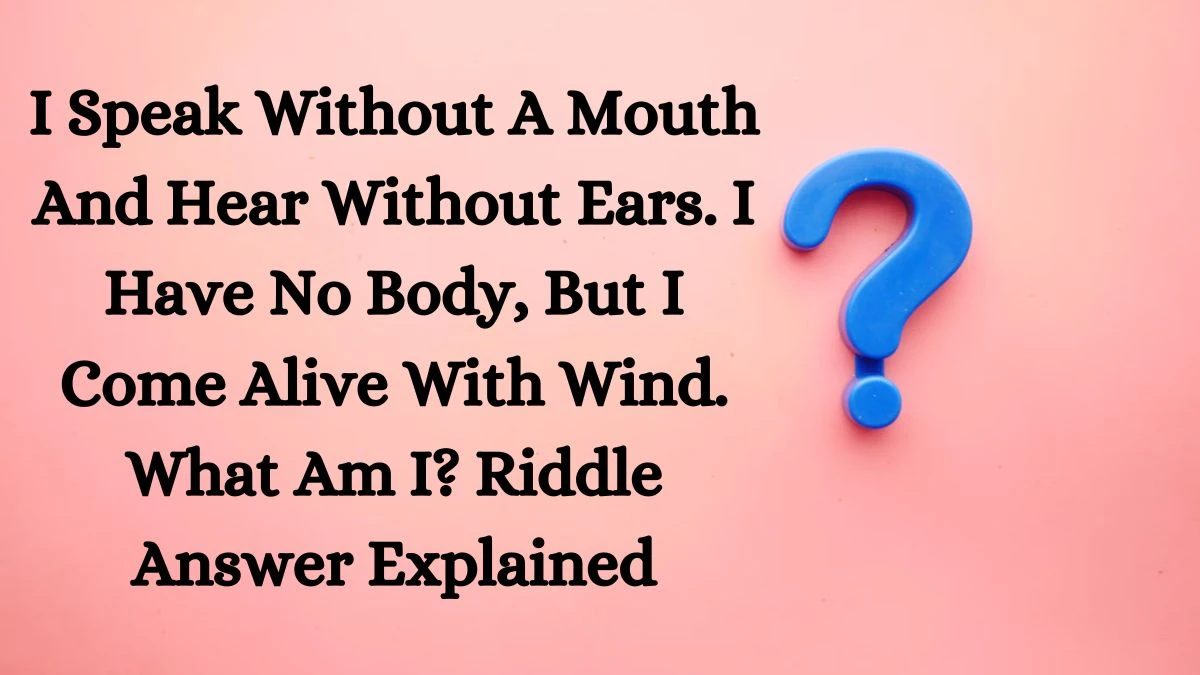I Speak Without A Mouth And Hear Without Ears. I Have No Body, But I Come Alive With Wind. What Am I? Riddle Answer Explained
by
Updated May 25, 2024

Riddles are word games that pose questions with unexpected yet logical answers, challenging our ability to think critically. Often, their solutions make us laugh, as they aim to trick and entertain us. This dual purpose makes riddles enjoyable and amusing. As such, they can serve as effective warm-ups for our brains before tackling mentally demanding tasks.
The following puzzle challenges us to expand our thinking and expand our vocabulary. This puzzle is suitable for children, adults and English language learners. Try to solve it without looking at the answer or share it with friends, family and colleagues.
I Speak Without A Mouth And Hear Without Ears. I Have No Body, But I Come Alive With Wind. What Am I? Riddle
Start your exploration with this classic riddle: I Speak Without A Mouth And Hear Without Ears. I Have No Body, But I Come Alive With Wind. What Am I? Get ready for a fun exercise in creativity and lateral thinking as you engage yourself in the world of linguistic adventure.
These phrases could initially appear to be paradoxical, a puzzle that defies logical reasoning. How can something listen without ears or talk without a mouth? The puzzle challenges us to investigate the infinite possibilities of language and go beyond the bounds of literal interpretation.
Think on the nature of communication that goes beyond physicality while you solve the puzzle. What beings in the world are able to communicate without using the conventional sense organs? Might the solution be found in the natural world, where invisible forces have a profound impact?
As time goes by, the puzzle becomes more intriguing, encouraging us to think about how everything is connected. Get ready to solve the mystery and find the hidden answer, where imagination and understanding meet.
Hints To Find The Answer
Let's break down the riddle and provide hints to help you decode it.
"I Speak Without A Mouth And Hear Without Ears"
- Think about something that can produce sound or convey information without having physical human features.
- It might not be a living being, but it interacts with sound.
"I Have No Body, But I Come Alive With Wind"
- Consider something that is activated or influenced by the movement of air.
- It might be an object or a phenomenon rather than a living creature.
By combining these hints, the answer should become clearer.
Answer To the Riddle
The answer to the riddle is an echo! Let's break down the clues and see why an echo fits the description perfectly.
Speaks without a mouth: An echo doesn't have a physical form like a human or animal, and therefore lacks a mouth to produce sound. But here's the trick: when you shout or make a noise, sound waves travel outwards. These waves can bounce off hard surfaces like mountains, walls, or even cliffs. When these reflected sound waves reach your ears, they are perceived as a repetition of the original sound. So, in essence, the echo "speaks" by reflecting the sound you made.
Hears without ears: An echo doesn't possess any biological ears to hear in the traditional sense. However, we can think of it metaphorically "hearing" the original sound because the reflection happens due to the initial sound wave reaching a surface and bouncing back.
No body: An echo isn't a tangible object. It's a phenomenon created by the interaction of sound waves and their environment. There's no physical body associated with an echo, just the sound wave itself.
Comes alive with wind: This clue is a bit more subtle. Wind can actually affect how we perceive echoes. Calm air allows sound waves to travel in a straight line, making echoes less likely or fainter. However, wind can disrupt this pattern, bending and carrying sound waves further. This can create stronger and more noticeable echoes, making it seem like the echo itself is "coming alive" with the movement of the wind.
So, while an echo doesn't have a physical body, mouth, or ears, it cleverly utilizes the properties of sound and the environment to create the illusion of speaking and hearing. The next time you hear an echo in a canyon or a large hall, remember the science behind this fascinating auditory experience.